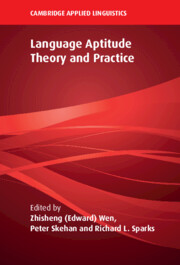Book contents
- Language Aptitude Theory and Practice
- The Cambridge Applied Linguistics Series
- Language Aptitude Theory and Practice
- Copyright page
- Contents
- Figures
- Tables
- Editors and Contributors
- Preface and Acknowledgments
- 1 Language Aptitude Research
- Part I Revisiting and Refining Aptitude Tests
- Part II Aptitude Testing of Diverse Groups
- Part III Innovative Perspectives and Paradigms
- Part IV Aptitude–Treatment Interaction (ATI)
- 14 The Role of Language Aptitude and Timing of Form-Focused Instruction in TBLT
- 15 Implicit (Not Explicit) Learning Aptitude Predicts the Acquisition of Difficult (Not Easy) Structure
- 16 Implicit Statistical Learning and Second Language Outcomes
- Part V Final Commentaries
- Index
- References
16 - Implicit Statistical Learning and Second Language Outcomes
A Bayesian Meta-Analysis
from Part IV - Aptitude–Treatment Interaction (ATI)
Published online by Cambridge University Press: 27 May 2023
- Language Aptitude Theory and Practice
- The Cambridge Applied Linguistics Series
- Language Aptitude Theory and Practice
- Copyright page
- Contents
- Figures
- Tables
- Editors and Contributors
- Preface and Acknowledgments
- 1 Language Aptitude Research
- Part I Revisiting and Refining Aptitude Tests
- Part II Aptitude Testing of Diverse Groups
- Part III Innovative Perspectives and Paradigms
- Part IV Aptitude–Treatment Interaction (ATI)
- 14 The Role of Language Aptitude and Timing of Form-Focused Instruction in TBLT
- 15 Implicit (Not Explicit) Learning Aptitude Predicts the Acquisition of Difficult (Not Easy) Structure
- 16 Implicit Statistical Learning and Second Language Outcomes
- Part V Final Commentaries
- Index
- References
Summary
Recent theoretical advances viewing language aptitude as multifaceted have led to accumulated evidence on certain constructs beyond the specifications of traditional aptitude tests. In this chapter, we consider the potential role of implicit statistical learning (ISL) mechanisms in second language acquisition (SLA). First, terminological and conceptual issues are examined with the goal of clarifying the processes and knowledge that ISL tasks are claimed to involve. Second, we consider justifications for research into the potential link between ISL and SLA by reviewing the argument for a default implicit processing mode in adult L2 learning. Third, we provide a synthesis of studies assessing the link between ISL and L2 outcomes based on the following research questions: (1) Which studies have examined the association between ISL tasks and L2 outcomes and what are their characteristics? (2) Which measures have been used to investigate the construct of ISL? And (3) What are the accumulated findings of the studies? The overall results of a Bayesian meta-analysis confirmed a positive, albeit weak, link between ISL and SLA (r =.13, [.05,.22]). Moderator analyses and a critical review of ISL tasks suggest avenues for future research.
Keywords
- Type
- Chapter
- Information
- Language Aptitude Theory and Practice , pp. 414 - 440Publisher: Cambridge University PressPrint publication year: 2023

